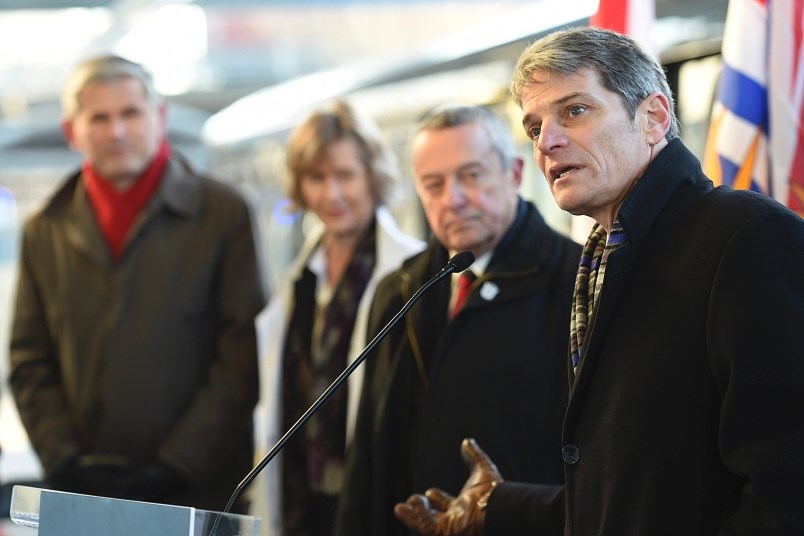Transit riders got some good news Friday – 28 new Skytrain cars will be added to the rapid transit line that runs across Metro Vancouver.
But the bad news is the train cars, which cost a combined $93 million, will not be in service until 2019.
It could have been a lot longer wait had Translink and the provincial government not already worked with Bombardier Transportation to deliver cars for the Evergreen extension, which opened this month and runs from Coquitlam’s Lafarge Lake to Burnaby’s Lougheed Mall.
That was the explanation provided by Translink CEO Kevin Desmond as he joined federal, provincial and municipal politicians Friday to announce the purchase of the new trains, which cost $3.3 million each, have a capacity of 320 riders and will be built in Plattsburg, New York.
“If we had to go through a brand new competitive procurement, that would have added at least a year to the process, and it might have been really like four or five years before cars got here,” said Desmond, noting the 28 cars will bring the fleet to 314. “So we took advantage of [the relationship with Bombardier] and began working with the province and Bombardier in the summer.”
The new cars are a component of the region’s mayors’ 10-year transit and transportation plan. The first phase of the plan, which costs $2 billion, calls for a total of 50 new train cars, 171 new buses, five new West Coast Express cars, more than $80 million for upgrading major road networks and almost $30 million to build and improve cycling infrastructure.
In the new year, Desmond said, transit riders can expect to see more frequent rail and bus service, along with more frequent HandyDart and SeaBus service. The SeaBus, for example, will offer service every 15 minutes throughout the day, every day of the week.
Desmond spoke to reporters at a station that will be the beginning connection to a $1.9-billion subway, which is supposed to run above ground along the Great Northern Way corridor and then begin to go underground near Main Street, under Broadway all the way out to Arbutus St.
Funding has not been secured for the subway line, which is included in phase two of the mayors’ plan, but Desmond said he was confident the working relationship Translink has with all three levels of government bodes well to get a subway built “in a few years.”
“I’m an optimist,” he said when asked about the timeline for a subway. “You can’t be in our business without being an optimist.”
Added Desmond: “I remain very confident. With the kind of partnership that we have at all levels of government -- and the importance of this to the future of the Metro Vancouver region -- we will see the day when these trains are operating further west. And I hope it’s coming pretty soon.”
Prime Minister Justin Trudeau announced in June that his government will provide cities $460 million under the new public transit infrastructure program. Trudeau promised during the 2015 federal election campaign to work with the provincial government to get a rapid transit line built along the Broadway corridor.
“The lack of federal funding will no longer be a roadblock to action,” Trudeau told reporters in September 2015 at a campaign stop at Cambie and Broadway.
Peter Fassbender, the provincial minister from Translink, took a reporter’s question Friday about the funding of a subway and said it is contingent on the next federal budget.
“Once that comes out, the provincial government will look at the commitment from the federal government and we’re working with the regional mayors in terms of some ideas they have for additional regional funding,” the minister said. “The beauty is, with phase one, we have the time to work out those details.”



